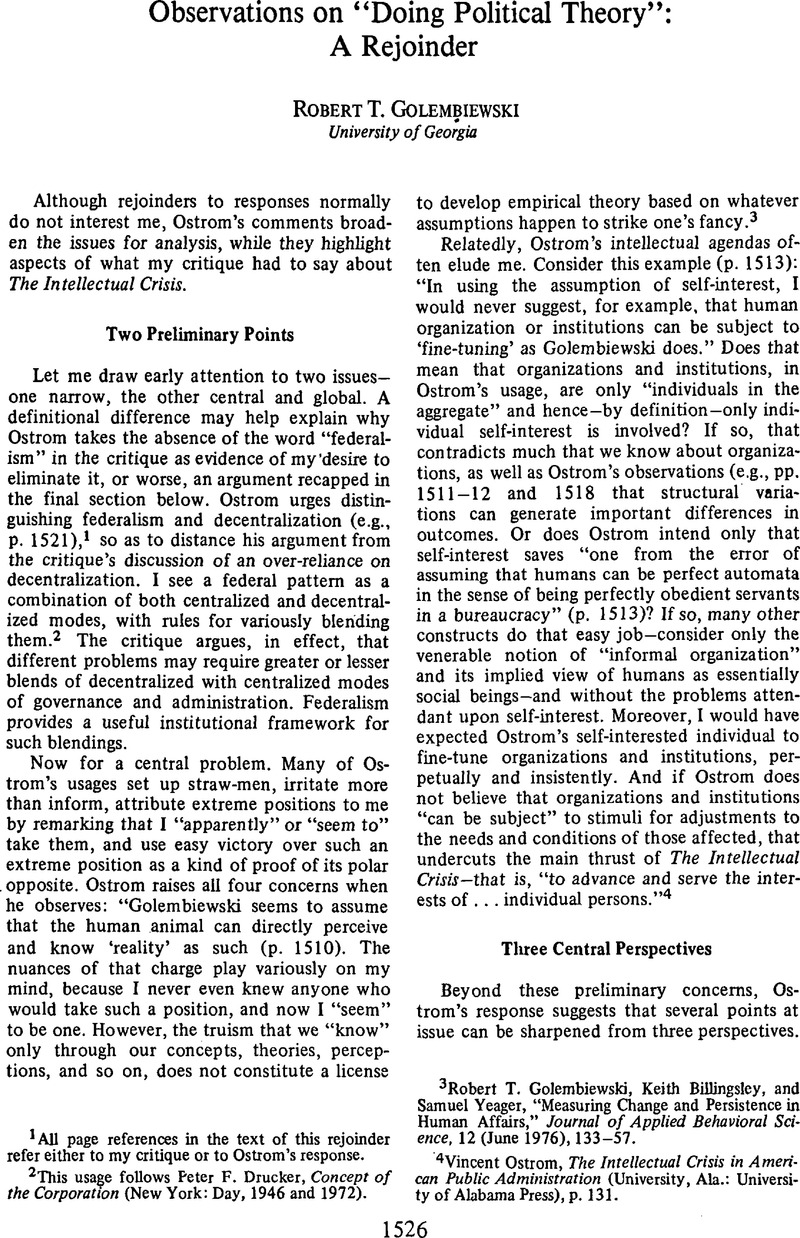Article contents
Observations on “Doing Political Theory”: A Rejoinder
Published online by Cambridge University Press: 01 August 2014
Abstract

- Type
- Reply
- Information
- Copyright
- Copyright © American Political Science Association 1977
References
1 All page references in the text of this rejoinder refer either to my critique or to Ostrom's response.
2 This usage follows Drucker, Peter F., Concept of the Corporation (New York: Day, 1946 and 1972)Google Scholar.
3 Golembiewski, Robert T., Billingsley, Keith, and Yeager, Samuel, “Measuring Change and Persistence in Human Affairs,” Journal of Applied Behavioral Science, 12 (06 1976), 133–57CrossRefGoogle Scholar.
4 Ostrom, Vincent, The Intellectual Crisis in American Public Administration (University, Ala.: University of Alabama Press), p. 131 Google Scholar.
5 Golembiewski, Robert T., Men, Management, and Morality (New York: McGraw Hill, 1965)Google Scholar.
6 Wilcox, Herbert, “The Culture Trait of Hierarchy in Middle Class Children,” Public Administration Review, 28 (05 1968), 222–35CrossRefGoogle Scholar.
7 See critique, fn. 51, for a brief list of a half-century of major criticisms of the traditional theory. Most attention was fixated on supporting what became the “imperial presidency,” although there were periodic bursts of attention to “grass roots administration” and experiments such as TVA.
8 Kuhn, Thomas S., The Structure of Scientific Revolutions (Chicago: University of Chicago Press, 1962), p. 15 Google Scholar.
9 See Kimberly, John R., “Organizational Size and the Structuralist Perspective: A Review, Critique, and Proposal,” Administrative Science Quarterly, 21 (12, 1976), 571–97CrossRefGoogle Scholar.
10 Wilson, James Q., Varieties of Police Behavior (Cambridge, Mass.: Harvard University Press, 1968), esp. pp. 227–77CrossRefGoogle Scholar, distinguishes three “styles” of “similar” departments, relating them to demographic, political, and historical differences.
11 The major impact of variations in managerial style on output and satisfaction–other things being more or less equal–illustrates the present point. See Thompson, James D., “Authority and Power in ‘Identical’ Organizations,” American Journal of Sociology, 62 (1956), 29–301 CrossRefGoogle Scholar.
12 Golembiewski, Robert T., Public Administration as A Developing Discipline (New York: Marcel Dekker, 1977): Vol. 1 Google Scholar: Perspectives on Past and Present; and Vol. 2: Organization Development as One of A Future Family of Mini-paradigms.
13 At the intra-organization level, see my “Civil Service and Managing Work,” American Political Science Review, 56 (12, 1962), 961–73CrossRefGoogle Scholar. For a current effort to tailor organization policies to one common time-bounded set of individual needs, see Golembiewski, “Mid-Life Transition and Mid-Career Change,” Public Administration Review (in press).
14 For example, one recent line of research seeks to establish the empirical and value advantages of an apparently-simple policy change at work, implemented in accordance with a specific set of values. See Golembiewski, Robert T., Hilles, Rick, and Kagno, Munro, “A Longitudinal Study of Flexi-Time Effects,” Journal of Applied Behavioral Science, 10 (12, 1974), 503–32CrossRefGoogle Scholar; and Golembiewski, and Hilles, , “Flexi-Time in a Large Firm,” Monthly Labor Review, 100 (12, 1976), 65–69 Google Scholar.
15 E.g., Golembiewski, Robert T., Renewing Organizations (Itasca, Ill.: F. E. Peacock, 1972)Google Scholar; and Golembiewski, Robert T. and Kiepper, Alan, “MARTA: Toward an Effective, Open Giant,” Public Administration Review, 36 (01, 1976), 46–60 CrossRefGoogle Scholar.
- 2
- Cited by





Comments
No Comments have been published for this article.